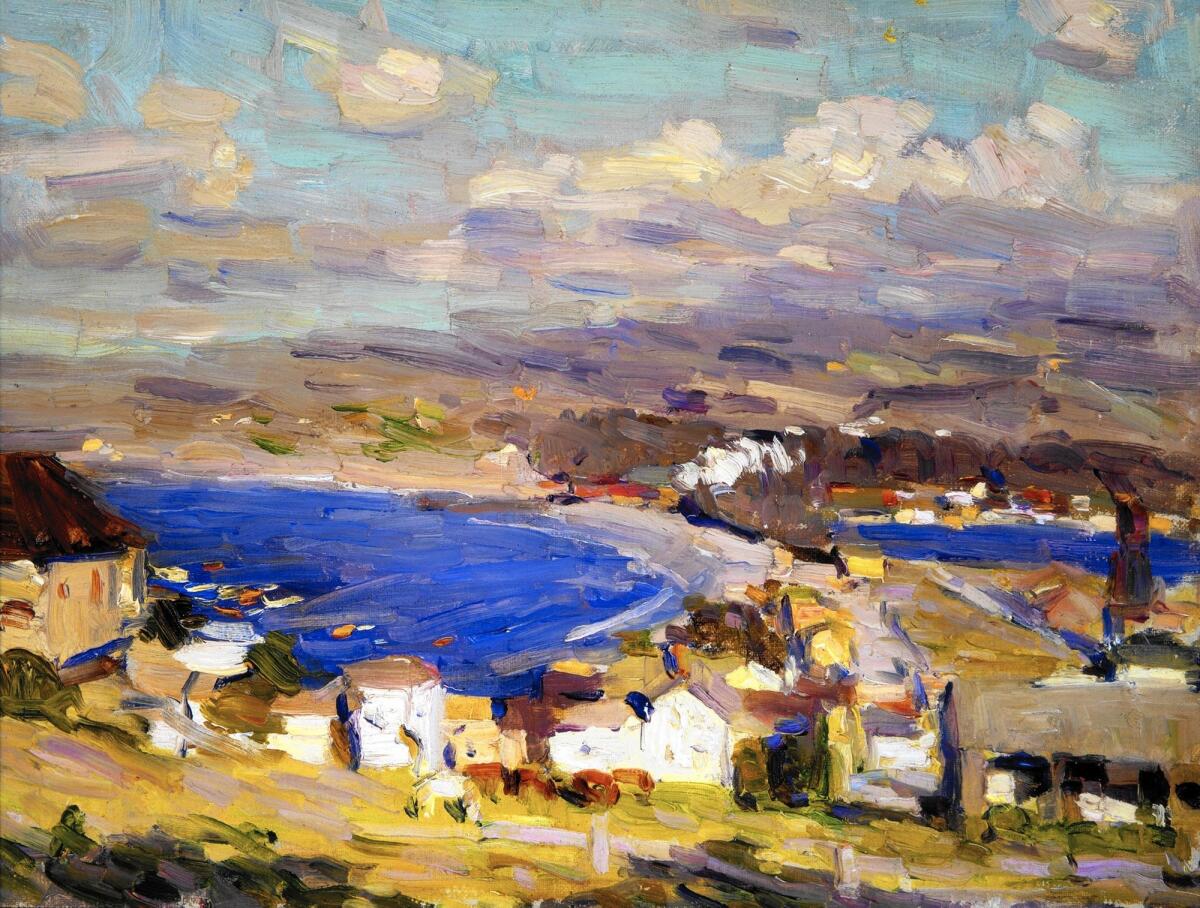Irvine Museum celebrates women’s art

Think about the great California artists of the 20th century. Some names might pop up, like William Wendt, Granville Redmond, Edgar Payne, Guy Rose, Millard Sheets, Richard Diebenkorn, Wayne Thiebaud and John Baldessari.
Women are not always part of the conversation. But an exhibition at the Irvine Museum aims to change that.
“Independent Visions: Women Artists of California 1880-1940” spotlights the achievements of female artists who created impressive paintings and sculptures in a variety of styles but often worked in the shadows of more famous men. The group show of about 40 works runs through Jan. 21.
The paintings range chronologically from Eliza Barchus’ majestic, realist oil on canvas, “Three Brothers, Yosemite” (1890), to Ruth Peabody’s edgy “Abstract Composition,” an oil on canvas created around 1936.
As Jean Stern, executive director of the Irvine Museum, puts it, many of the female artists had the same education and artistic training as the men. But, like women in other fields, they were caught in the inequities of their time.
“They were not afforded the same economic opportunities as the men,” Stern said. “Therefore, it was a double-edged sword, because the men artists generally found a dealer, they found a market and they painted in essence the same painting over and over again to meet the market demands. The women artists — it was unseemly for a woman to earn a living. They didn’t have the same availability to the marketplace as the men, so they weren’t tied to one style, so they were free to explore.”
Take Donna Schuster, for example. The longtime Los Angeles and Orange County resident has a couple of female portraits in the exhibit that are typical of American Impressionist work. Yet, she also has a couple of later paintings, “Still Life with Blue Bowl” and “Los Angeles Harbor,” that are more akin to Post-Impressionism and utilize the bright, bold colors of the Fauvists.
“You could easily map out five different periods in her art, where there were distinctly different styles,” Stern said. “The women were the big experimenters.”
“Independent Visions” features watercolor paintings by Marion Kavanagh Wachtel, who is now considered one of the most gifted watercolorists of her time. She was married to Elmer Wachtel, also a highly regarded artist whose favored mediums were oil and pen and ink. Marion didn’t want to compete with her oil-painting husband, so she largely avoided that medium, but she took watercolors to new heights.
Large, tropical paintings by Jessie Arms Botke kick off the show. They once decorated the ballroom at the Oaks Hotel in Ojai, part of a gigantic mural that was on display from 1953 to 1992. In 1992, the hotel underwent a renovation and donated the Botke work to the newly formed Irvine Museum.
The Irvine exhibit also features works by Anna A. Hills, an important figure in Orange County art history. She was one of the founding members of the Laguna Beach Art Assn. in 1918, and served as its president from 1922 to 1925 and again from 1927 to ’30. Under her leadership, the association purchased land at Pacific Coast Highway and Cliff Drive and built a gallery that would become the Laguna Art Museum.
“We’re getting a lot of really great feedback,” said Dora James, the museum’s curator of education, about the current exhibition. “Sometimes it seems like women artists never existed before. They did struggle for a long time to get recognized. I remember when I was studying art, in the textbook on page 599, there was Georgia O’Keeffe. That was about it. Here, people are surprised we have a whole exhibit with just women.”
Other artists in the show include Mabel Alvarez, Loren Barton, Elanor Colburn, Meta Cressey, Euphemia Charlton Fortune, Mary Hobart, Grace Carpenter Hudson, Evelyn McCormick, Louise Nimmo, Elsie Palmer Payne, Henrietta Shore, Julia Bracken Wendt, Blanche Whelan and Edith White.
The works on view are from the museum’s permanent collection, the Irvine family collection, and from other private collectors, including Janet and Mark Hilbert, who are supporting a museum of California art at Chapman University that is expected to open on a temporary basis in February.
Founded by Joan Irvine Smith, the Irvine Museum is on the ground floor of the 17-story Airport Tower, an office building located in an otherwise nondescript, business sector of Irvine. The museum used to be on the 12th floor of the building but relocated to the more spacious ground floor in 2002.
The private, nonprofit museum does not receive any government funding and is supported by a foundation whose chairwoman is Irvine Smith and president is her son, James Irvine Swinden.
The free museum sponsors school tours and pays for bus transportation. The museum also offers tours every Thursday at 11:15 a.m. and provides private tours for groups of 10 or more.
Stern hopes this exhibition of women’s art will travel to other venues.
“This is so popular,” he said. “People love this show.”
*
IF YOU GO
What: “Independent Visions: Women Artists of California 1880-1940”
Where: 18881 Von Karman Ave., Suite 100, Irvine
Hours: 11 a.m. to 5 p.m. Tuesdays through Saturdays
Cost: Free
Information: (949) 476-0294 (for general information and to book group tours); irvinemuseum.org
